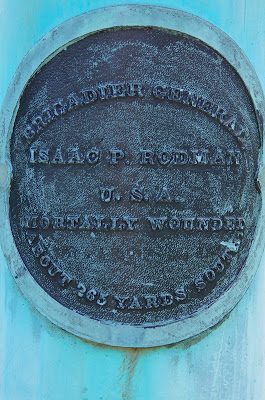The 39th Illinois Volunteer Infantry was mustered into federal service on October 11, 1861. The regiment traveled to St. Louis from whence they were ordered to Williamsport, Maryland on October 29, 1861. The inexperienced troops were assigned as railroad guards, to protect the Baltimore and Ohio Railroad, in the Department of West Virginia. The regiment's companies were split up and assigned to various strategic locations in West Virginia including Bath (present day Berkeley Springs), Alpine Station (present day Hancock) and Great Cacapon Bridge.
In early January 1862 during the Bath-Romney Campaign soldiers of the 39th Illinois were attacked by 8,500 veteran soldiers commanded by Stonewall Jackson. The Illinoisians were pushed across the Potomac to Hancock, Maryland as Jackson's troops destroyed the railroad from Great Cacapon to Hancock before heading west toward Romney.
In late January and February, 1862 the 39th was deployed to guard the railroad at Cumberland, Maryland and later New Creek, Virginia. The weather was cold and miserable. Many of the soldiers were without adequate food, clothing or shelter. Several died of disease. Others of the 39th died of unknown causes. They were originally buried at Cumberland, Maryland and later disinterred and reburied at Antietam National Cemetery.
Private/Drummer Charles Rowley, from Homer, Illinois enlisted in Company G, 39th Illinois Volunteer Infantry. He died at Cumberland, Maryland of unknown causes on February 20, 1862.
Private William H. Perry a resident of Esmona, Illinois mustered in with Company C, 39th Illinois in October 1861. He died at Cumberland, Maryland of unknown causes on February 25, 1862.
Private Harmanus Borchers of Peoria enlisted in Company G of the 39th. He died of disease at Cumberland, Maryland on February 13, 1862.
Private George H. Mott of Wilmington, Illinois enlisted in Company A. 39th Illinois. He died of unknown causes at Culberland, Maryland on February 2. 1862.
Private William S. Littleton, a resident of Mahomet enlisted in company I, 39th Illinois. he died at Cumberland of unknown causes on February 6, 1862.
Private Hiram G. Dunham, a resident of Hartford, Michigan enlisted in Company G, 39th Illinois. He died of disease at Cuberland, Maryland on February 23, 1862.
There are ten soldiers from the 39th Illinois buried at Antietam National Cemetery. Seven of those died near Cumberland, Maryland in February 1862. Non of the deaths are attributed to being killed or wounded in battle.






























